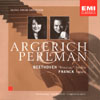Beethoven/Franck Violin Sonatas
Two of the greatest musicians of the day team up for some memorable music-making in two of the most popular violin [sonata] sonatas
View record and artist detailsRecord and Artist Details
Composer or Director: Ludwig van Beethoven, César Franck
Label: EMI Classics
Magazine Review Date: 3/2000
Media Format: CD or Download
Media Runtime: 60
Mastering:
DDD
Catalogue Number: 556815-2

Tracks:
| Composition | Artist Credit |
|---|---|
| Sonata for Violin and Piano No. 9, 'Kreutzer' |
Ludwig van Beethoven, Composer
Itzhak Perlman, Violin Ludwig van Beethoven, Composer Martha Argerich, Piano |
| Sonata for Violin and Piano |
César Franck, Composer
César Franck, Composer Itzhak Perlman, Violin Martha Argerich, Piano |
Author: Edward Greenfield
Perlman and Argerich, both big musical personalities, strike sparks off each other in these vividly characterised readings of Beethoven's Kreutzer and the Franck Sonata, recorded live in July 1998. Ensemble is not always immaculate, and audience noises intrude, but this playing could not be more vital. In the Kreutzer, the first movement is fiery and dramatic, the slow movement warmly expressive, and the finale sparkily volatile. The recording, not as immediate as most of Perlman's studio recordings, gives us a better idea than usual of his full range of dynamic and tone.
The approach is strikingly different from the straighter, far less volatile reading which Perlman recorded for Decca with Vladimir Ashkenazy over 25 years earlier in 1973. So it is, too, in the Franck Sonata, which Perlman also recorded with Ashkenazy for Decca in 1968. In a work less formally structured than the Beethoven, the spontaneous interplay of Perlman and Argerich makes for a feeling of rhapsodic improvisation, very apt for this work. The opening finds Argerich deeply reflective, conveying mystery far more than Ashkenazy, before Perlman launches into the Allegro at a markedly faster speed. Some may resist the expressive freedom, whether in phrasing, rubato or in fluctuations of tempo, but the magnetism will for most be irresistible, even when the playing is not immaculate, as in the second-movement Allegro. This is intensely vital music-making, thrillingly captured on the wing.
The approach is strikingly different from the straighter, far less volatile reading which Perlman recorded for Decca with Vladimir Ashkenazy over 25 years earlier in 1973. So it is, too, in the Franck Sonata, which Perlman also recorded with Ashkenazy for Decca in 1968. In a work less formally structured than the Beethoven, the spontaneous interplay of Perlman and Argerich makes for a feeling of rhapsodic improvisation, very apt for this work. The opening finds Argerich deeply reflective, conveying mystery far more than Ashkenazy, before Perlman launches into the Allegro at a markedly faster speed. Some may resist the expressive freedom, whether in phrasing, rubato or in fluctuations of tempo, but the magnetism will for most be irresistible, even when the playing is not immaculate, as in the second-movement Allegro. This is intensely vital music-making, thrillingly captured on the wing.
Discover the world's largest classical music catalogue with Presto Music.

Gramophone Digital Club
- Digital Edition
- Digital Archive
- Reviews Database
- Full website access
From £8.75 / month
Subscribe
Gramophone Full Club
- Print Edition
- Digital Edition
- Digital Archive
- Reviews Database
- Full website access
From £11.00 / month
Subscribe
If you are a library, university or other organisation that would be interested in an institutional subscription to Gramophone please click here for further information.




